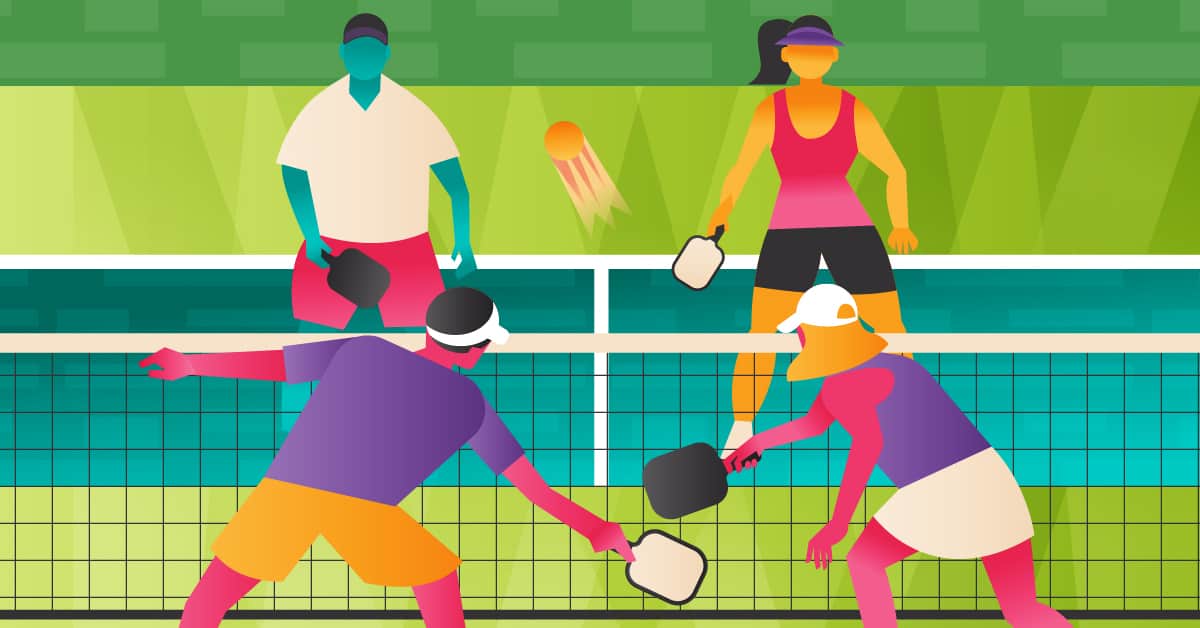Pickleball. It’s the game with the funny name, and it’s the fastest growing sport in the U.S.
Pickleball was developed in 1965 by three fathers in Washington State who were looking to create some summer fun. It combines elements of tennis, badminton, and ping pong into an aerobic workout that can benefit both your physical and mental health. Below, we’ll tell you about the surprising benefits of playing pickleball, give you the lowdown on how and where to play, and pass along some tips on avoiding injury on the court.
The Benefits of Pickleball
Pickleball is a fast-paced game that requires players to move quickly across a court and rally a hard plastic ball over a net. Naturally, getting outdoors and getting moving offers a slew of benefits for the players involved. To start, decades of research proves that exercise can reduce depression and anxiety while improving self-esteem. In fact, a 2021 study found that participants who played pickleball in particular discovered improvements in both their cognitive performance and their vertical jump after just six weeks — good news for those looking for a way to keep their mind and body toned. Another study found that middle-aged and older adults who played three hours of pickleball over six weeks showed improved cardiorespiratory fitness, cholesterol, and blood pressure.
Additionally, pickleball is a social sport — perfect for two or four players. So, gather your friends to play a game or join a game at your local gym or park. You might have a new hobby before you know it.
Pickleball etiquette when playing with strangers is simple: introduce yourself, be gentle and encouraging with new players, and thank everyone after the game. Perhaps in part because of the collaboration involved, studies have found that playing pickleball can contribute to successful aging and enhance the daily lives of older adults.
Intrigued? Here’s How to Get Started
Pickleball requires relatively simple equipment. Each player needs a paddle, and the group needs a standard plastic pickleball (with holes) and a court with a net. Players should also wear loose, breathable clothing in layers that can be easily removed, as well as a hat or visor to guard against sunburn.
Good shoes are also essential; be sure to wear court shoes with ankle support and rubber soles that grip. When the treads on the toe boxes and/or heels of your shoes wear down — usually after three or four months of consistent play — it’s time to replace them.
Pickleball games take place outdoors as well as at special indoor facilities. A typical court measures 20 feet by 44 feet, and it’s striped like a tennis court, with right and left service areas. The first 7 feet on either side of the net is called the “kitchen”; players aren’t allowed to stand inside it when volleying. Faults occur when the ball hits the net, goes out of bounds, or is volleyed before an initial bounce on either side.
The rules of the game can strike new players as complex, but they become routine after a few rounds. Remember that the player in the right-hand service square serves the ball diagonally. Serves should also be done underhand, with ball and paddle below the waist. After the ball makes it over the net, it must bounce once on each side before players can begin to volley competitively. A team keeps serving until they fault, at which point, the serve goes to the next team. Points are only scored by the serving team, and the first side to score eleven points, leading by two points, is the winner.

Many gyms and local parks now offer pickleball courts and lessons. If you’re not sure where to find a pickleball court, USA Pickleball has a website search feature which enables you to find a court in your area. You could also join an official pickleball club. Kids who love the game can connect with other young players via the USA Pickleball website, and wheelchair pickleball is also an option, as many chapters of Special Olympics now offer it as a sport. And if you find yourself getting serious about the sport, consider participating in the Professional Pickleball Association or the U.S. Open Pickleball Championships.
How to Prevent Pickleball Injuries
While some players may find themselves a bit strained after a spirited match of pickleball, some simple preventative measures can keep you in the game. To prevent strains and sprains and tendonitis, be sure to warm up your muscles with a variety of exercises. Try warming up by jogging in place or around the court. Do lunges, jumping jacks, toe touches, and arm circles, among other basic warmups.
Remember to wear UV-blocking sunglasses to prevent eyestrain, and drink plenty of water to ward off dehydration. You’ll likely want a high-protein snack in between games, or directly afterward, as well.
If you do sprain or strain a shoulder, wrist, or ankle, the Mayo Clinic suggests following the R.I.C.E. recovery rules. Rest the injured part and place an ice pack on it every two or three hours for 15 minutes at a time. Compress the injured body part with an elastic sports wrap, and keep it elevated above your heart as much as possible, especially when sleeping. Start gentle, gradual movement again after two days.
Conclusion
There’s a reason pickleball has captivated players across the country. It’s a fun and social form of serious exercise for people of all ages. Whether you’re looking for something fun to do with your family or trying to make some new friends, pickleball is a great opportunity to get out of your comfort zone and get your body moving. With a little preparation and practice, you’ll be volleying balls across the court with the best of them.
